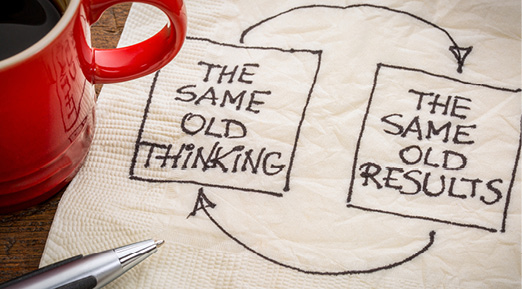Innovation is for everyone
Using design thinking to build a culture of innovation
Giselle Diego & Zoe Pappas

Right Thinking
An innovation culture is something that can be nurtured and developed in any organisation using a variety of methods. We have been working with clients across sectors using design thinking as the basis for our approach to innovation. Facilitated processes like hackathons and co-design workshops are a great way to kick off a renewed focus for innovation and provide employees with an opportunity to participate, to learn and to make mistakes in a safe environment.
We often hear organisations tell us ‘innovation is one of our values but we aren’t an innovative organisation’. Innovation has taken on this almost religious like position with promises of (business) salvation and complete (organisational) transformation. The high priests of this innovation religion are the Jobs, Bezos and Musks of this world.
With this as the backdrop, it is little wonder that most organisations do not feel capable of being more innovative. We had one client tell us ‘we’re not in the business of mobile phones, innovation doesn’t apply to us’. If you are bringing greater value to people you serve, greater than they have today, that’s innovation.
At Right Lane, we believe that it is time to demystify and ‘de-deify’ innovation in order for it to have applicability and, more importantly, impact for organisations. Innovation requires creative thinking. We all have the capacity to be creative we just need different ways to be creative. Organisations can develop a culture that fosters the creativity of all employees; it takes leadership and a commitment to trying over and over again.
An innovation culture can be fostered using many methods. We have been working with clients across sectors using design thinking as the basis for our approach to innovation. In this article, we describe what design thinking is and two different approaches we have used with various organisations: hackathons and co-design.
 Design thinking as a toolkit
Design thinking as a toolkit
‘Design thinking – first used to make physical objects – is increasingly being applied to complex, intangible issues, such as how a customer experiences a service’ (Kolko 2015). Design thinking is a systematic approach to problem solving that uses tools and methods from design in order to arrive at more innovative solutions.
Different approaches to design thinking
There are different ways to approach the phases of design thinking, for example, Stanford’s d.school, a pioneer in design thinking, identify five steps in the process: empathise, define, ideate, prototype, test. Whereas IDEO, world leading design and innovation firm, describe four phases: gather inspiration, generate ideas, make ideas tangible and share your story. Jeanne Lietdka, a leading design thinking expert and practitioner from Darden Business School, asks four questions: what is, what if, what wows, and what works?
Regardless of how the approach is structured or described they all share three core beliefs: understand needs, broaden the horizon of what is possible and iterate and test solutions multiple times.
Design thinking is human centred on two levels: we begin with understanding the end users needs and centre those needs throughout; and the process itself is a social one, it necessitates collaboration and effective team work.
Design thinking meets business thinking
Business thinking and design thinking are seemingly incongruous but as Tim Brown of IDEO points out ‘business thinking is integral to design thinking … a design solution can only benefit from the sophisticated analytical tools … that have evolved in the business sector’ (Brown 2009). Increasingly design is being seen as a competency that creates business value for organisations. McKinsey & Company (Edson et al. 2017) is conducting research into the connection between business value and design and their preliminary findings suggest there are three broad themes that appear to correlate with improved financial performance in design-led organisations: first, design is more than a department; second, design is more than a phase; and third, design is more than a feeling.
Becoming a design-led organisation requires leadership commitment and involves everyone. Over the last 18 months, we have been working with clients on their innovation challenges applying the principles of design in different ways.
Hackathons
What started off in software development as an intensive process where teams get together and build a software solution in a short period of time, 24 or 48 hours, is now broadening in its scope. These intensive environments are being used in business, government and the social sector as a way of approaching a problem in a different way with a view to finding an innovative solution in a short, defined period of time.
At Right Lane, we combine this intensive hackathon environment with design thinking used as the problem solving methodology. At our hackathon events, participants are given an organisational challenge to work through and working in small teams step through some of the design thinking phases to guide them to arrive at an idea to pitch.
Teams start by understanding their end users needs and this can take various forms. For example we have: filmed current and former clients and played the video during the workshop; asked staff to come in and be interviewed by their colleagues; interviewed stakeholders and customers ahead of the workshop and developed profile posters to be reviewed; and developed customer archetype booklets and posters that teams review during the workshop.
Teams identify insights and focus on a particular part of the problem they will be solving for. Teams are then led through a structured brainstorming process to really push them to think expansively in terms of what is possible. With a wide net of ideas they then zero in and choose an idea to prototype. A prototype is a representation of the idea that someone can interact with; for example, some of our hackathon participants have developed role plays, posters, 3D models, written songs and developed storyboards.
Prototypes are then presented for feedback either to a panel of judges or to the same people that were interviewed at the beginning of the hackathon. Judging panels are often made up of senior people within the organisation, such as the executive team, or customers.
We always wrap up our hackathons with a discussion on what the actions and next steps are for the ideas developed so as not to lose momentum. A common criticism of innovation processes is that ideas are developed and no one sees what happens to them; it’s important to chart a clear course of action coming out of the event.
Co-design
Co-design, which is often referred to as participatory design, is about bringing external people into a design process as contributors. Using co-design asks us to think of our customers and stakeholders as experts. Bringing them into the problem-solving process can lead to meaningful outcomes with impact. This is because our customers and stakeholders have the most to teach us.
The idea is that you speak to your customers before you have even dreamed of the final solution. By getting your product or service in front of end users early, and understanding their reaction, you can work towards a differentiated, value-added solution. This can take the form of regular feedback sessions with customers, or stakeholders, or it can be part of a more formal process such as developing a new product. Co-design de-risks a project as you can iron out issues before rolling out an entire new product or service.
Right Lane recently worked with StateCover Mutual Limited on a product co-creation process. The process began with one-on-one interviews with customers and stakeholders to understand their needs. The conversations were expansive and provided rich qualitative data. The team drew insights from this data and participated in an ideation workshop with numerous rounds of structured brainstorming and prioritisation. Small teams were allocated two to three ideas to develop over a short period of time.
A co-design workshop was held where each customer and stakeholder interviewed was invited back to provide feedback to teams. Each team presented their various prototypes to each stakeholder individually. Then the whole group came together for an overview of themes and stakeholders provided general feedback to all teams. Ideas were prioritised, collapsed into others or parked and a plan of action was confirmed to take a number of ideas into the next stage of development.
 StateCover CEO/MD Linda Bostock said of the process: ‘As a Mutual, member centricity is fundamental to our sustainability. So, the co-design process where we invite our members to participate in our product development, has a perfect alignment with our business model. So much so that we plan to incorporate co-design into our strategic planning process – it’s a great way to capture those insights that are critical to meeting the future needs of our members. Not only this, but the process is a great way to energise the team and support staff engagement. It’s a win-win!’
StateCover CEO/MD Linda Bostock said of the process: ‘As a Mutual, member centricity is fundamental to our sustainability. So, the co-design process where we invite our members to participate in our product development, has a perfect alignment with our business model. So much so that we plan to incorporate co-design into our strategic planning process – it’s a great way to capture those insights that are critical to meeting the future needs of our members. Not only this, but the process is a great way to energise the team and support staff engagement. It’s a win-win!’
Intentional by-products of these approaches
Facilitated innovation processes, such as a co-design process, provide environments where employees from different areas can work together and learn from each other. Collaboration is essential for innovation: ‘great projects are achieved by great teams … even the most legendary inventor is often a team in disguise’ (Kelly 2001). Getting teams together to work on a creative problem can be a great way to improve collaboration in your organisation.
In any situation where we have brought customers and stakeholders into the room and asked them for their perspective and feedback, both sides have extolled the virtues of the approach. For customers or stakeholders, they appreciate being asked for their perspectives and find it interesting problem solving especially when the outcome has a direct impact on them. For the organisation, they gain rich insights that they can use to iterate a solution and move them towards an outcome they may not have thought of on their own. The process also builds trust between parties.
Facilitated processes are a great way to kick off a renewed focus on innovation and gives teams tools to apply in their day-to-day work or to be applied to their own innovation project. Increasing your organisation’s capability for innovation can be as simple as committing to regular brainstorm sessions or seeking feedback on ideas from other parts of the organisation. You don’t need to invent a phone or app to be innovative you just need to give your organisation permission to ask ‘how might we do this differently?’
References
Brown, T 2009, Change by Design, Harper Collins, New York
Edson, J, Kouyoumjian, G & Sheppard, B 2017, More than a feeling: Ten design practices to deliver business value, McKinsey Design Insights, viewed 5 December 2017, <https://www.mckinsey.com/business-functions/mckinsey-design/our-insights/more-than-a-feeling-ten-design-practices-to-deliver-business-value>
Kelly, T 2001, The Art of Innovation, Currency Double Day, New York
Kolko, J 2015, ‘Design Thinking Comes of Age’, Harvard Business Review, September
© 2017 Right Lane Consulting
